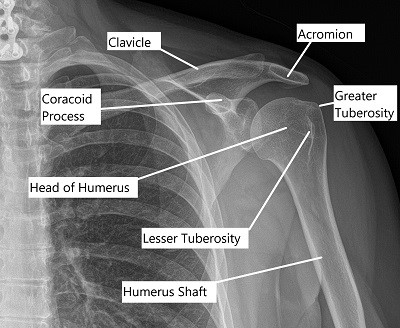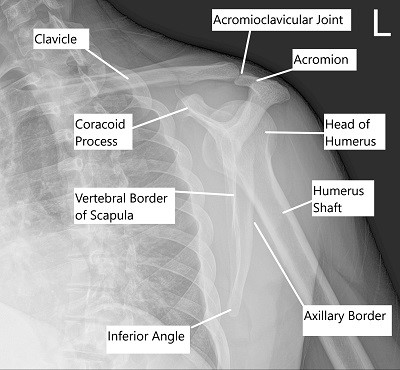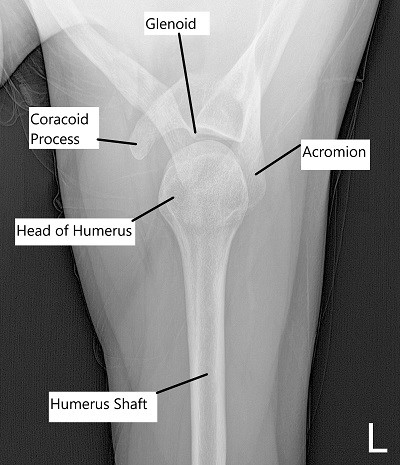Shoulder Anatomy
The shoulder is made up of three bones: the shoulder blade or scapula, the arm bone or humerus, and the collar bone or clavicle. These three bones are connected to make two joints: the glenohumeral (GH) joint and the acromioclavicular (AC) joint. They, in turn, are attached to the rib cage through two joints: the scapulothoracic and the sternoclavicular joints.

Axial view of left shoulder.
Glenohumeral Joint
The Glenohumeral or the real shoulder joint is made up of the articulation of the ball of the head of the arm bone called the humerus into the cup of the shoulder blade called the scapula.
The cup makes only 1/8th of the circumference of the shoulder and hence the shoulder joint is seemingly unstable, especially if compared to other large ball and socket joints of the body that is the hip joint. The joint can be involved in arthritis and well as fractures and sprains
Acromioclavicular Joint
The acromioclavicular joint (AC joint) is formed by articulation of the shoulder blade (scapula) and the collar bone (clavicle) and is enclosed by a joint (AC) capsule and supported by multiple ligaments.
It can be felt under the skin in front and over the top of the shoulder. AC joints can be involved in acute presentation leading to AC sprain of various grades (shoulder separation). It can also be involved by arthritis causing pain over time.

Transscapular view of Left shoulder.

Anteroposterior view of Left Shoulder.
Stability of Glenohumeral Joint
The cup of the shoulder joint is deepened secondary to the presence of a fibrocartilaginous rim around the cup of the shoulder in the form of a gasket called the labrum. This provides some degree of stability to the shoulder joint.
The stability of the shoulder joint is further strengthened by the capsule of the shoulder joint as well as the surrounding muscles which keep the head or the bulb of the humerus in place over the cup.
The capsule and the labrum can be injured in an accident leading to shoulder dislocation or due to repetitive trauma caused by certain sports like baseball and volleyball, leading to instability and the shoulder popping out.
Muscles around the shoulder
The shoulder is wrapped around by multiple muscles. One major muscle includes the deltoid which is on the outer aspect of the shoulder and helps in the elevation of the arm.
Another group of important shoulder muscles is called rotator cuff muscles. They include four muscles, the subscapularis which is present in the front, the supraspinatus which is present on the top, the infraspinatus and teres minor which are present on the back of the shoulder joint.
All these four muscles merge to each other to form a continuous tendinous cuff that arises from the shoulder blade (scapula) and inserts itself around the head of the arm bone (humerus). This confluent tendinous portion of these muscles is called the rotator cuff.
The rotator cuff is important in stabilizing the ball onto the socket as well as in elevation of the arm and inside and outside rotation of the arm. The rotator cuff can be inflamed, or calcified leading to disability of the shoulder joint. The rotator cuff can be torn due to acute injury or more commonly repeated use over time. The pain usually disturbs sleep and is associated with weakness and inability to lift the arm above the shoulder level.
The rotator cuff is present in a space between the bulb or the head of the humerus and a projection of bone coming out of the scapular bone called Acromion. Normally, there is enough space for the tendon to glide smoothly. There is enclosed lining on the outside of the cuff called the subacromial bursa which helps in smooth gliding of the cuff underneath the acromion.
Due to bone spurs (osteophyte) on the acromion, there may be impingement of the rotator cuff or inflammation of the subacromial bursa leading to pain and disability of the shoulder.
The acromioclavicular (AC) joint is stabilized by the capsule as well as ligaments attaching the clavicle to the shoulder blade. Due to injury or arthritis (spurring) the bursa in subacromial space may be inflamed causing pain and restriction of movement. The spurring of the acromion can lead to rotator cuff tears of inflammation.

Dr. Vedant Vaksha
I am Vedant Vaksha, Fellowship trained Spine, Sports and Arthroscopic Surgeon at Complete Orthopedics. I take care of patients with ailments of the neck, back, shoulder, knee, elbow and ankle. I personally approve this content and have written most of it myself.
Please take a look at my profile page and don't hesitate to come in and talk.
